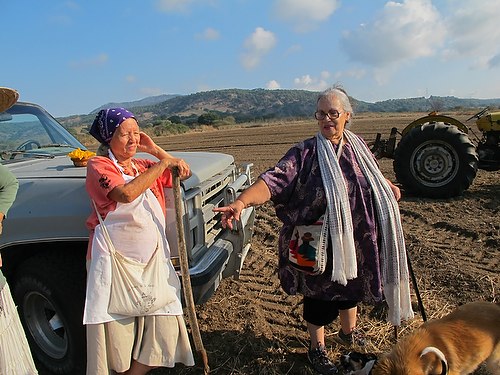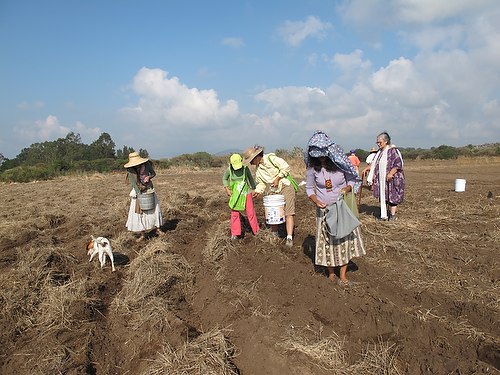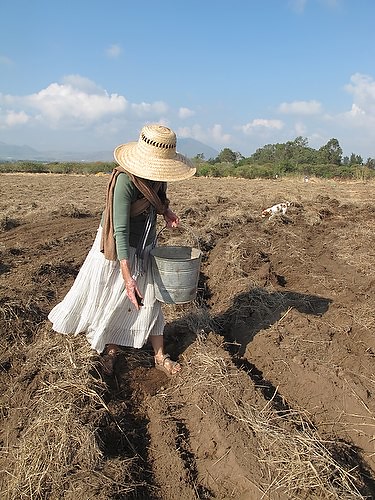The planning had taken a long time, and the date had been postponed three days in a row – rain, problems with the tractor, but Friday night, the word went out: The next morning would be the Siembra de Mujeres.
There had been collective plantings before, but it was the first time at Teopantli Kalpulli that the women joined to plant their own milpa, the traditional planting of corn, beans and squash. I have never planted a milpa before, and I was excited to join them. At 7:30 I was waiting in front of the temple, my brand new coa in hand (the coa, I had learned from these women, is a beautiful and ancient agricultural tool that opens the ground easily and smoothly for the insertion of a few seeds, without the planter needing to bend down).
The morning was fresh and bright, with a veil of clouds draped around the crowns of the mountains in the distance. The sun shone on an aromatic earth abundant with the rains of the previous week, but dry enough to crumble easily in the hands. It was indeed a good day to plant.

Abuela Esperanza, elegantly attired for the occasion in purple, has a disability that makes it hard for her to walk very far, but she drove her truck up to the site and supervised, sharing advice and tidbits of wisdom. She, Bety and Luz Vertila took a look at the way the land was sloping and decided to make semicircular furrows to deter erosion and hold the water in place when it rains. Bety took my coa and a piece of red yarn, tied on one end to the edge of the field, and traced the semicircle in the dirt.

We had support from a few of our menfolk – most importantly, Rodolfo, with the tractor, but also Lukas, Fernando and David. Rodolfo brought the tractor around and followed Bety’s semicircle but the dried grass left over from last year kept getting caught in the tines. It also piled up in big clumps along the furrows, making it hard to figure out where to plant. It was all quite complicated but eventually the women devised a way to pile the grasses between the furrows and the planting resumed.
Here is where the teamwork came in, and I discovered the beauty of collective planting. Every foot and a half, a woman would drop three grains of corn; halfway in between, the woman behind would drop one or two beans, and every 20 paces, a squash. A third woman followed, tossing in a handful of composted manure for fertilizer, and closed the furrow with a well-placed flick of the foot.

I worked for awhile with a lovely mother-daughter team, Claudia and Daimara. An hour into our work we had the rhythm down, and some began to sing their thanks to the Mother Earth and the Great Spirit that is Father to us all. At the center of our field, Abuela Amanda created an altar with a cazuela of grains and squash blossoms as an offering. And at each of the points of the four directions and at the center, our textile artist Sofi dug a hole, inserted the bamboo pole and raised a flag, a different, carefully crafted design for each of the cardinal points.

I brought a container of cut papaya and a bag of peanuts to share, and midway through the siembra I delivered the treats to each of the women to keep their energy up. Sofi and Fernando came later with agua de jamaica, ice-cold red hibiscus tea, that refreshed us all.
We finished our task by mid-afternoon and each of us went home to bathe and rest. That night, each of us in our own homes, awoke to the the satisfying patter of rain on our roofs – a blessing on the maiz and on each of its sembradoras.
Created with Admarket’s flickrSLiDR.

Leave a Reply